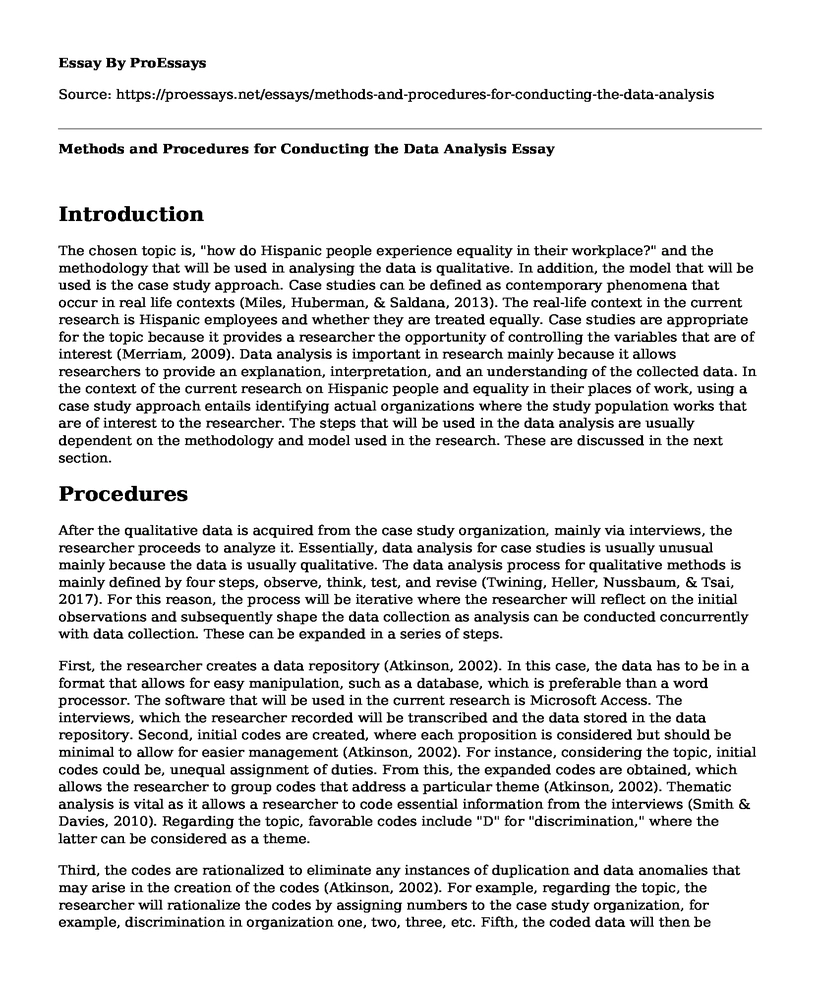Introduction
The chosen topic is, "how do Hispanic people experience equality in their workplace?" and the methodology that will be used in analysing the data is qualitative. In addition, the model that will be used is the case study approach. Case studies can be defined as contemporary phenomena that occur in real life contexts (Miles, Huberman, & Saldana, 2013). The real-life context in the current research is Hispanic employees and whether they are treated equally. Case studies are appropriate for the topic because it provides a researcher the opportunity of controlling the variables that are of interest (Merriam, 2009). Data analysis is important in research mainly because it allows researchers to provide an explanation, interpretation, and an understanding of the collected data. In the context of the current research on Hispanic people and equality in their places of work, using a case study approach entails identifying actual organizations where the study population works that are of interest to the researcher. The steps that will be used in the data analysis are usually dependent on the methodology and model used in the research. These are discussed in the next section.
Procedures
After the qualitative data is acquired from the case study organization, mainly via interviews, the researcher proceeds to analyze it. Essentially, data analysis for case studies is usually unusual mainly because the data is usually qualitative. The data analysis process for qualitative methods is mainly defined by four steps, observe, think, test, and revise (Twining, Heller, Nussbaum, & Tsai, 2017). For this reason, the process will be iterative where the researcher will reflect on the initial observations and subsequently shape the data collection as analysis can be conducted concurrently with data collection. These can be expanded in a series of steps.
First, the researcher creates a data repository (Atkinson, 2002). In this case, the data has to be in a format that allows for easy manipulation, such as a database, which is preferable than a word processor. The software that will be used in the current research is Microsoft Access. The interviews, which the researcher recorded will be transcribed and the data stored in the data repository. Second, initial codes are created, where each proposition is considered but should be minimal to allow for easier management (Atkinson, 2002). For instance, considering the topic, initial codes could be, unequal assignment of duties. From this, the expanded codes are obtained, which allows the researcher to group codes that address a particular theme (Atkinson, 2002). Thematic analysis is vital as it allows a researcher to code essential information from the interviews (Smith & Davies, 2010). Regarding the topic, favorable codes include "D" for "discrimination," where the latter can be considered as a theme.
Third, the codes are rationalized to eliminate any instances of duplication and data anomalies that may arise in the creation of the codes (Atkinson, 2002). For example, regarding the topic, the researcher will rationalize the codes by assigning numbers to the case study organization, for example, discrimination in organization one, two, three, etc. Fifth, the coded data will then be analyzed, and the researcher has to consider the database design, such as the queries that can be used to obtain the desired output (Atkinson, 2002). Lastly, the final propositions are made (Atkinson, 2002). In the context of the current topic, propositions include the assertion that there is discrimination of Hispanics in organization one or two as they are given more roles and duties at a lesser pay than the other employees.
References
Atkinson, J. (2002). Four steps to analyze data from a case study method. ACIS 2002 Proceedings, 38.
Miles, M.B., Huberman, A.M. & Saldana, J. (2013). Qualitative data analysis. London, UK: Sage Publications.
Merriam, S. B. (2009). Qualitative research: A guide to design and implementation. San Francisco, CA: Jossey-Bass.
Smith, K., & Davies, J. (2010). Qualitative data analysis. In Practical research and evaluation: A start-to-finish guide for practitioners. (pp. 145-159). London, UK: SAGE Publications Ltd.
Twining, P., Heller, R. S., Nussbaum, M., & Tsai, C. C. (2017). Some guidance on conducting and reporting qualitative studies. 1-16.
Cite this page
Methods and Procedures for Conducting the Data Analysis. (2022, Jul 20). Retrieved from https://proessays.net/essays/methods-and-procedures-for-conducting-the-data-analysis
If you are the original author of this essay and no longer wish to have it published on the ProEssays website, please click below to request its removal:
- Children's Mercy Healthcare Facility Analysis
- McDonald's Strategic Analysis
- Evaluating Market Research Tools Paper Example
- Ethics and Quantitative Business Research Paper Example
- Essay on Pro Sports Bike: Internal Analysis to Identify Characteristics & Performance
- Conducting a SWOT Analysis of Starbucks: Leveraging Strengths, Weaknesses, Opportunities & Threats
- Qualitative Analysis: Analyzing Chemical Properties for Cosmetics Manufacturing - Essay Sample







